Sizing Space Station V
Space Station V was much more difficult to size than the Orion 3 spaceplane. Three main sources of data were used:
1: An article by Fred Ordway, in Spaceflight magazine
2: View looking out of the docking bay, showing human workers for approximate scale.
3: Shots showing Orion 3 entering the docking bay.
4: painting by McCall showing the Orion 3 exiting the docking bay.
The article "2001: A Space odyssey," by Ordway (date unknown, as the Spaceflight staff saw fit not to put dates on the pages... gah), states flat out, "The huge, 1000-ft diameter, spinning station..." This could close the book on the size of the station, but the same article also calls the Discovery 700 feet long... a size not readily supported. So, as with the Aurora model dimensions for the Orion 3, Ordway's diameter is taken not as absolute, but as a starting point.
In order to progress further in scaling the station, an accurate drawing of the station, such as is available for the Orion 3, is needed. However, to date no production drawings for the space station seem to have come to light; therefore I had to create my own. Figure 1 shows a 2-D CAD drawing of the SSV, as accurate as I can make it with available data. It is not yet finished; many, many details need to be added, but the general shapes and proportions, after much effort, are, I believe, correct.
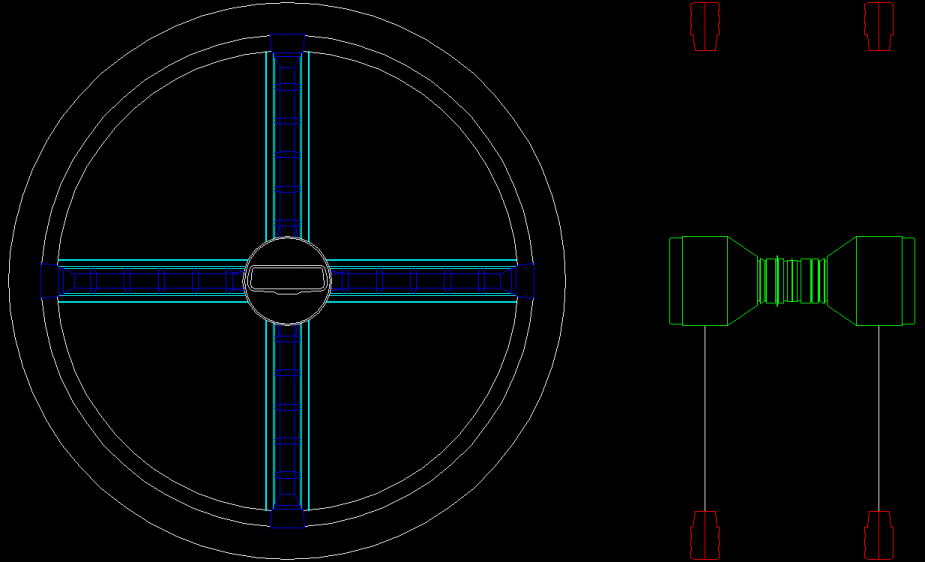
Figure 1: In-progress CAD drawing, Space Station V
The only direct scale comparisons are with the orion 3, and one scene looking out of the launch bay. In the "floor," "walls" and "ceiling" of the bay are insets with some EXTREMELY large windows, behind which can be seen people working, sitting, walking around, etc. A direct comparison between apparent height in pixels of one of the figures and the height of the bay can be made. This is complicated by the fact that the windows are recessed somewhat, and this must be accounted for. Also, the view angle on the figures in not dead-on, so some educated guesswork is needed. A height from between 44 and 49 feet seems to fit for the launch bay. When scaling the rest of the station from the height of the bay, diameters from 1196 to 1332 feet are produced. While in the ballpark of what Ordway suggested, these are nonetheless notable larger.

Figure 2: View out of launch bay.
What should be the most direct comparison would be between the Space Station and the well-established Orion 3. Several shots of the Orion 3 approaching the station are available. However, in none of them are the Orion 3 shown clearly; the edges seem to fade out... but they can still be seen well enough to get a rough idea as to scale.
In Figure 3, a side view of the spaceplane can be seen nearly entering the station. The length of the spaceplane can be compared to the maximum diameter of the hub of the station. Form this, and going off of the established 165-foot length of the Orion 3, the hub is seen to be 358 feet in diameter... leading to a station diameter of 2240 feet. This is well beyond what was expected.
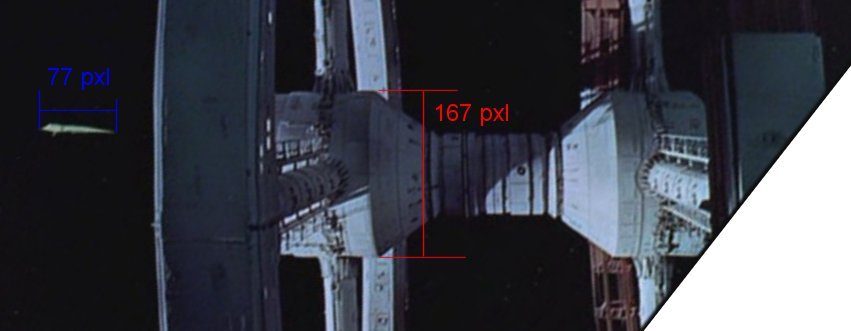
Figure 3: screencap showing Orion 3 approaching station hub.
The final scale comparison is again between the space station and the spaceplane... but not from the film, but from promotional art. A painting by Robert McCall shows an Orion 3 jetting away from the station, and close enough to get good scale comparisons. Two means are available: measureing wingspan vs. hub diameter, and length vs. hub length. For this, a full-scale postwer was used, and dimensions are in directly measured centimeters. (the poster shows more area than the small scan below)
The wingspan vs. diameter measurement (Figure 4) gives a hub diameter (actually, the slightly smaller outer face of the hub) of 172 feet, based on an 85 foot span. This gives a station diameter of 1121 feet.

Figure 4: Span vs. Diameter
The length vs. hub length measurement (Figure 5) gives a hub fractional length of 74 feet, based on an Orion 3 length of 165 feet. This fractional hub length equates to a station diameter of 909 feet.
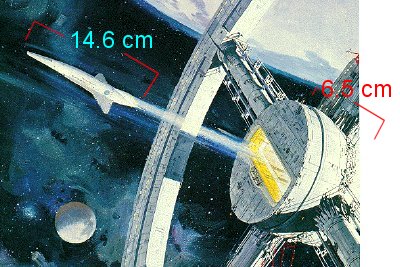
Figure 5: Length vs. length
Something to bear in mind about using the McCall painting: it's not canon, and the perspective is pretty pronounced. The spaceplane is closer to the view than the hub is; this argues in favor of a larger hub and consequently a larger diameter. Also, note that the spaceplane is shown shooting out of the bay at apparently full power... two things that are out of place. The spaceplane goes in nose first, comes out tail first; there's no room to turn around... and it certainly wouldn't use full power.
From all this, and especially the launch bay views, a diameter of 1200 feet was tentatively settled upon. The views showing the spaceplane approaching the station were essentially rejected as being simply silly; if you watch closely, the station and the spaceplane are seen to be rotating about quite different axes... and let's face it, a nearly half-mile diameter station is a bit much to swallow. The McCall artwork is take not as a primary source, but as useful confirmation of general scale. Also, a 1200 foot diameter station provides a launch bay 44 feet high... which will come in handy when the Aries lunar shuttle is sized.
Efforts were made to scale the station based on the sizes of the windows, ceiling heights and so on, but success was limited due to a cascade of vague measurements, as well as uncertainty regarding the change in size between inner and outer windows. Ceiling height was estimated at 6.75 feet due to Figure 6.
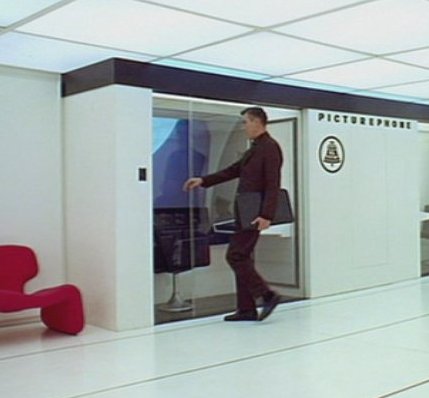
Figure 6: Ceiling height compared to person
A last effort was made to sanity check the 1200 foot diameter. Shown in Figure 7 is a blowup of the CAD model, showing the floor and ceiling of the upper level of the rim, with a 6.75 foot ceiling height (in red). The horizontal white line is a 150 foot length (Ordway has written that the full scale set was 150 feet long).
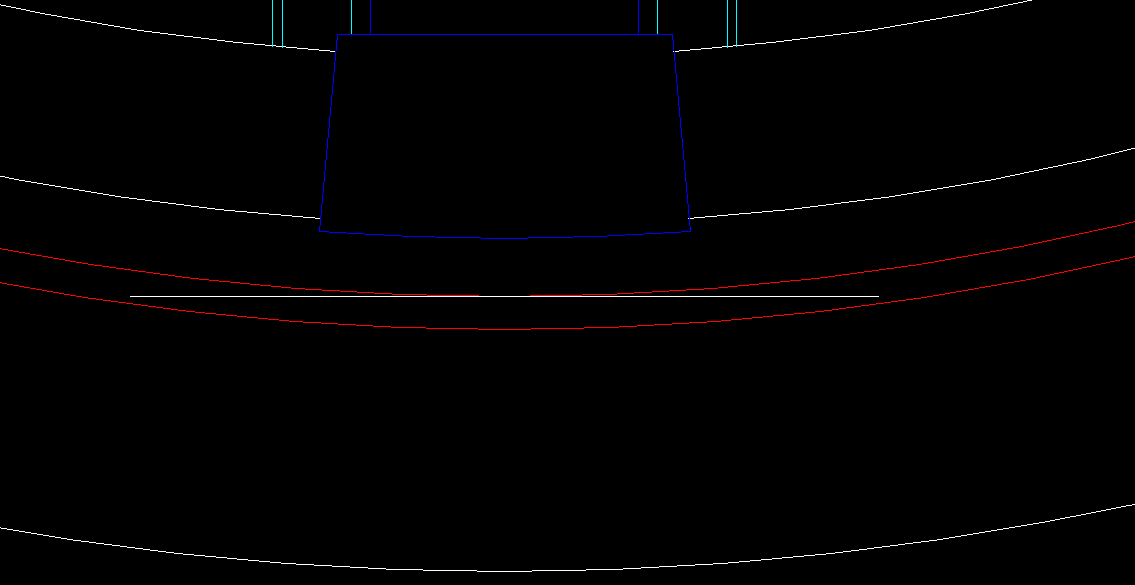
Figure 7: CAD layout of upper level
Figure 8 shows a distant view of two figures; they are shown to be at just about the distance where they are becoming fully visible. While the inclination of the floor is at best difficult to determine due to the camera angle, it would appear at first blush to be generally similar to the 150 foot length of floor as described by the CAD drawing in Figure 7.
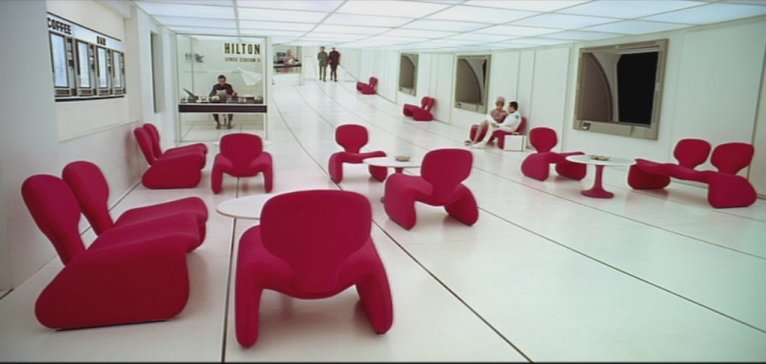
Figure 8: Rim interior
After all this, the diameter was settled on as being 1200 feet.
NEXT: Sizing the Aries 1b
Contact me by e-mail
lexcorp@ix.netcom.com








